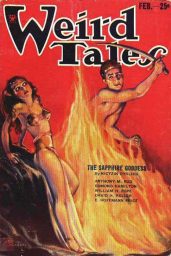 There have been a number of Weird Tales anthologies but interestingly, no best of Weird Tales.
There have been a number of Weird Tales anthologies but interestingly, no best of Weird Tales.
If you were to put together a Best of Weird Tales, what stories would you include? Here is my list:
The Call of Cthulhu H. P. Lovecraft
Beyond the Black River Robert E. Howard
The Tale of Satampra Zeiros Clark Ashton Smith
Your’s Truly, Jack the Ripper Robert Bloch
Skeleton Ray Bradbury
Slime Joseph Payne Brennan
The Cult of the White Ape Hugh B. Cave
Mr. George August Derleth (as Stephen Grendon)
The Sapphire Goddess Nictzin Dyalhis
He That Hath Wings Edmond Hamilton
Revelations in Black Carl Jacobi
Masquerade Henry Kuttner
The Hounds of Tindalos Frank Belknap Long
Shambleau C. L. Moore
The Werewolf of Ponkert H. Warner Munn
Saladin’s Throne-Rug E. Hoffmann Price
Roads Seabury Quinn
The Tree Men of M’Bwa Donald Wandrei
The Valley Was Still Manly Wade Wellman
Jumbee Henry S. Whitehead
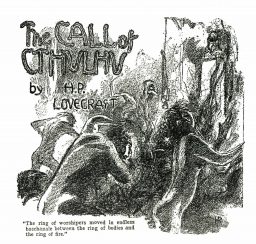 This is heavy on the big names of the magazine but includes most of the qualified second stringers. There are a few stories by more obscure writers that might make the grade, Mearle Prout’s “ “Masquerade” for example. I could make a case for E. F. Benson’s ”The Wishing Well” though Benson was not a Weird Tales writer per se. Some would probably make the case for G. G. Pendarves though I have not read anything by her that really has grabbed me.
This is heavy on the big names of the magazine but includes most of the qualified second stringers. There are a few stories by more obscure writers that might make the grade, Mearle Prout’s “ “Masquerade” for example. I could make a case for E. F. Benson’s ”The Wishing Well” though Benson was not a Weird Tales writer per se. Some would probably make the case for G. G. Pendarves though I have not read anything by her that really has grabbed me.
H. P. Lovecraft’s “The Call of Cthulhu” is the story that kicked off the whole “Cthulhu Mythos” which shows no sign of abating anytime soon. In terms of influence, this is my pick. “The Dunwich Horror” runs a close second. In some ways, “The Dunwich Horror” is the more typical “Mythos” story, but “Call” was the game changer.
Picking that one Robert E. Howard story is difficult. One could use “The Shadow Kingdom,” “Worms of the Earth,” “Wings in the Night,” or “Queen of the Black Coast” as worthy entries. “Beyond the Black River” though has Conan, Picts, elder sorcery, and a little philosophy thrown in.
Clark Ashton Smith is another difficult choice. Smith maintained a very high level overall that there are relatively few weak stories in his corpus. “The Vaults of Yoh-Vombis,” 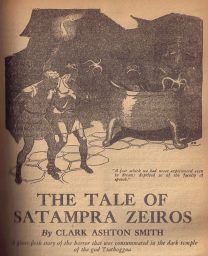 “The Beast of Averoigne,” “The Dark Eidolon, or “The Empire of the Necromancers” come to mind a top notch stories. I am sure others would put forth their candidates. “The Tale of Satampra Zeiros” was one of the first Smith stories I read and it made an impact on me. A story of what can go wrong when you have the roguish thief character in sword and sorcery come up against something unexpected.
“The Beast of Averoigne,” “The Dark Eidolon, or “The Empire of the Necromancers” come to mind a top notch stories. I am sure others would put forth their candidates. “The Tale of Satampra Zeiros” was one of the first Smith stories I read and it made an impact on me. A story of what can go wrong when you have the roguish thief character in sword and sorcery come up against something unexpected.
Robert Bloch started out as an H. P. Lovecraft imitator. He started to come out from Lovecraft’s shadow in 1938. This story from the July 1943 issue was adapted for the Thriller T.V. show in the early 60s. Bloch got further mileage when Captain Kirk took on Jack the Ripper from a screenplay by Bloch.
Ray Bradbury is another difficult choice. You can’t go wrong with just about any of his stories from Weird Tales. This is one of the stories that got included first in Dark Carnival and then The October Country.
Joseph Payne Brennan was one of the last great names to come out of Weird Tales. Most of you probably did not know he started in the western pulp magazines before he was in Weird Tales. One of the best giant protoplasm horror stories ever written.
Hugh Cave had a burst of activity in Weird Tales from 1932 to 1934 adding some depth to the contents during beginning of the “golden age.” I remember liking this one when reading the Carcosa Press collection Murgunstrumm. I had the chance to mention this story to Hugh in person at Pulp-Con in 1995.
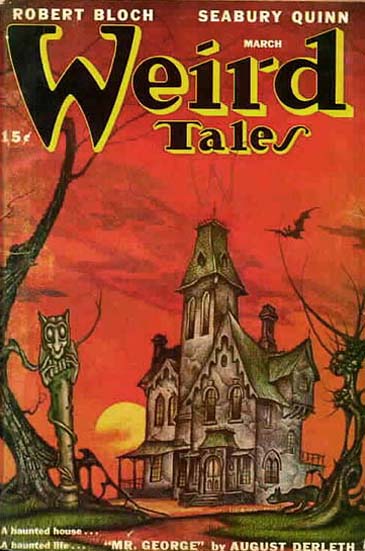
August Derleth’s “Mr. George” was another Thriller adaptation. I think it showcases Derleth’s strong points. He just wasn’t a doom and gloom guy. Don’t let his Cthulhu Mythos/Lovecraft imitations put you off. As John Haefele puts it in his The Derleth Mythos, August Derleth was the writer from Weird Tales with the highest literary profile. He had been awarded a Guggenheim Fellowship and sponsored by Sinclair Lewis. An alternative story to “Mr. George” is “A Gentleman From Prague.”
Nictzin Dyalhis was popular with readers of Weird Tales. He had only eight stories in the magazine. “When the Green Star Waned” is an early space opera story. It might be ground breaking though not particularly good. “The Saphhire Siren” is a case of early sword and sorcery fiction.
Steve Haffner of Haffner Press once said to me that early Edmond Hamilton stories have great ideas but not so good writing. He was one of the most prolific contributors to Weird Tales and also the main science fiction writer for the magazine. Somewhere in the middle 1930s, Hamilton’s writing improved. His prose became more literate, almost lyrical. “He That Hath Wings” from 1938 is example of Hamilton in fine form.
Carl Jacobi was another of those very solid second stringers of Weird Tales during the golden age. He also was one of 1930s writers selling to the magazine in the 1940s, when a fair number of Wright’s writers got cut. “Revelations in Black” has become acknowledged as one of the great vampire stories of the 20th Century. Jacobi’s stories in general are atmospheric with no excess verbiage.
Henry Kuttner along with Robert Bloch carried Weird Tales in the late 1930s after Howard and Lovecraft were dead, and Clark Ashton Smith had almost quite writing prose. Kuttner wrote some Lovecraft imitations, some sword and sorcery, and space opera. This story has Kuttner pretty much in his own style. This is one of his last stories about a house of killers thinking they have gotten the best of a stranded young married couple. Another adaptation for Thriller with Tom Poston and Elizabeth Montgomery.
Frank Belknap Long is best remembered for being H. P. Lovecraft’s friend. He lived into his 90s providing a memoir of Lovecraft. Long was not a great writer in general though he did produce a few classics. His “The Space Eaters” is one of the first Lovecraft influenced cosmic horror stories outside of Lovecraft. “The Hounds of Tindalos” is one of the first Lovecraft/Cthulhu Mythose stories (with Lovecraft’s blessing)
C. L. Moore along with Robert E. Howard and Clark Ashton Smith created the golden age of Weird Tales in the 1930s. Unfortunately, Farnsworth Wright, editor of Weird Tales, had an adversarial relationship with H. P. Lovecraft. As a result, Lovecraft was almost completely missing in action from 1932 to late 1936. “Shambleau” was Moore’s first story. Her stories often took first or second place in popularity. Her “Northwest Smith” character is presented as a rogue, a proto-type for Han Solo in ways though he is rather passive in the stories. A melding of horror, myth, and science fiction that she used again and again.
H. Warner Munn decided to write a story from the viewpoint of the werewolf. H. P. Lovecraft suggested the idea in “The Eyrie” in Weird Tales. Munn ran with it.
E. Hoffmann Price was another long lived writer who wrote about those he met. He is the only one to have met Lovecraft, Howard, and Smith. He later went on to become a high producing pulp fictioneer. He was known for writing stories that are a fantastic Middle East. “Saladin’s Throne-Rug” has a haunting ending. “The Stranger From Kurdistan” has some fame and would be an alternative pick.
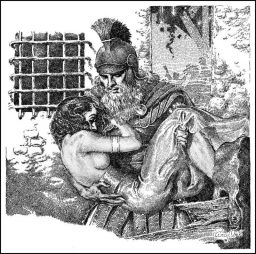 If I remember correctly, August Derleth actually beats out Seabury Quinn for having the most stories in Weird Tales, but not by much. Much of Quinn’s fiction was the tiresome “Jules de Grandin” series where a French doctor and expert on everything thwarts various supernatural (and sometimes non-supernatural) menaces in the town of Harrisonville, N.J. “Roads” is the greatest fantastic Christmas story ever written. Quinn gives an origin story for Santa Claus.
If I remember correctly, August Derleth actually beats out Seabury Quinn for having the most stories in Weird Tales, but not by much. Much of Quinn’s fiction was the tiresome “Jules de Grandin” series where a French doctor and expert on everything thwarts various supernatural (and sometimes non-supernatural) menaces in the town of Harrisonville, N.J. “Roads” is the greatest fantastic Christmas story ever written. Quinn gives an origin story for Santa Claus.
My personal opinion is from a technical standpoint Donald Wandrei was the best writer from Weird Tales. He had a command of language that beat out everyone else. Clark Ashton Smith was more over the top, Wandrei beats him due to his restraint. Wandrei also wrote cosmic fiction of a sort not seen today. “The Tree Men of M’Bwa” reminds me a little of Jack London’s “The Red One” though much more pulsating. His “The Red Brain” would be the alternative selection for “best of.”
Manly Wade Wellman along with Robert Bloch and for a short time, Ray Bradbury, carried Weird Tales for most of the 1940s. He got going just when Howard and Lovecraft died. “The Valley Was Still” was adapted for The Twilight Zone. The story is a little understated but that is how Wellman rolled for the most part. The Devil attempts to make a deal with the Confederacy to win the Civil War.
Henry S. Whitehead has his adherents. He was another understated writer though he got more blood and thunder right before he died. Whitehead made use of his time in the U.S. Virgin Islands to make use of voodoo and zombies. This is a voodoo zombie tale in fact. The locale and atmosphere are certainly authentic.
So, here you have the big names, some famous stories from a legendary magazine. It would be a book that you could take with you on vacation, to return to, or give to someone who knows absolutely nothing about Weird Tales (including college professors).
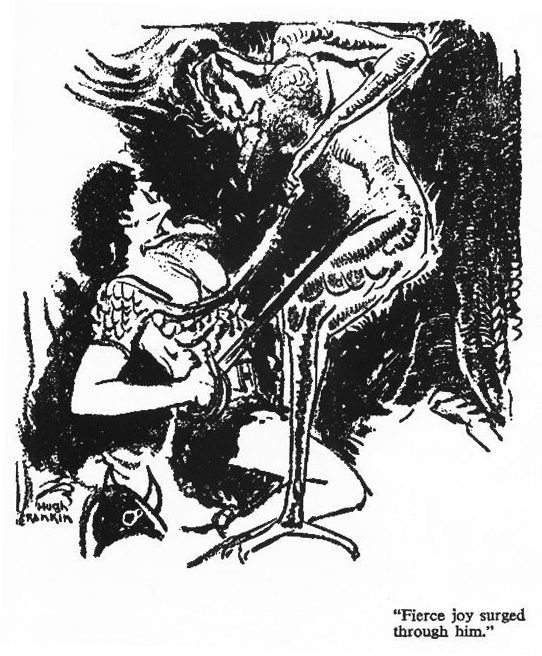
Beyond the Black River
Few people could find anything of consequence to argue about faced with a contents page like that. Different people might have preferences for alternative stories by certain authors but I’m pretty sure most would muster a roster of contributors that closely parallels yours.
Perhaps a good way to recruit some lesser known names would be to split the anthology into three volumes: Best of WT of the 20s, the 30s and the 40/50s.
Am surprised you didn’t see fit to include “The Three Marked Pennies”. Surely one of the most popular stories WT ever published.
What story is the drawing of the bearded Centurion (gothic?) carrying the damsel from?
-
“Roads” by Seabury Quinn
Great list. I have yet to read a few of these tales, so I will dig into my library and see if I have ’em. Personally, I find Worms of the Earth a better example of weird Howard, as Beyond the Black River strikes me as an excellent frontier adventure tale with a little “weird” added to meet the needs of Weird Tales. Just my 2 cents…
Good selection. I’d probably select “The Dark Eidolon” for CAS’s representative, that or ‘The Double Shadow.” I also originally prefered Moore’s “Black God’s Kiss,” but can see a strong case for “Shambleu” as representative of the type of SF Wright published. Some other stories by lesser writers are also worthy of inclusion:
1. “Far Below” by Robert Barbour Johnson (Dorothy McIlwraith voted this the best story ever to appear in WT);
2. “The Canal” by Everill Worrell (if worried about too many vampire stories, then “Leonora” by the same writer, which is really creepy. Worrell is an undeservedly little known mainstay of the mag);
3. “The Mystery of the Last Guest” by “John Flanders” (Jean Ray): proof that WT was an international phenomena;
4. “Ghost Hunt” by H. R. Wakefield (a masterpiece from the last few years of the magazine):
5. “The Night Wire” by H. F. Heard;
6. “In Amundsen’s Tent” by John Martin Leahy
7. “Bells of Oceana” or “The Ghosts of Steamboat Coulee” by Arthur J. Burks:
8. “The Floor Above” by M. L. Humphreys
I would also include Benson’s “The Wishing Well,” and possibly Algernon Blackwood’s “Roman Remains.”
Oh yes: “The Phantom Farmhouse” is a much better story than “Roads.” The latter has always struck me as a bit to schmaltz for my tasty.
My personal pick for Howard would be Pigeons Form Hell, which you didn’t mention. But your chocie, great.
“YOurs Truly Jack the Ripper” requires an essentially impossible coincidence to work, so, sorry, can’t agree.
Roads is probbaly Quinn’s best s tory, but so atypical of his work.
I’d liek an audioook please with Amber Benson, Alexis Denisof, and James Masrters tradign off the readings. Amebr’s part needs to icnldue He That Haht Wings
Would certainly buy such a book Love to see Morgan H as editor